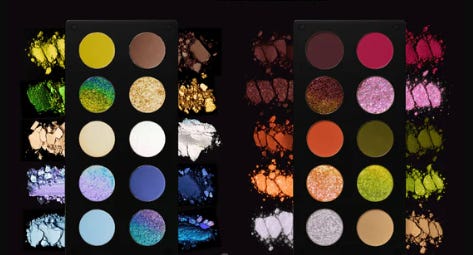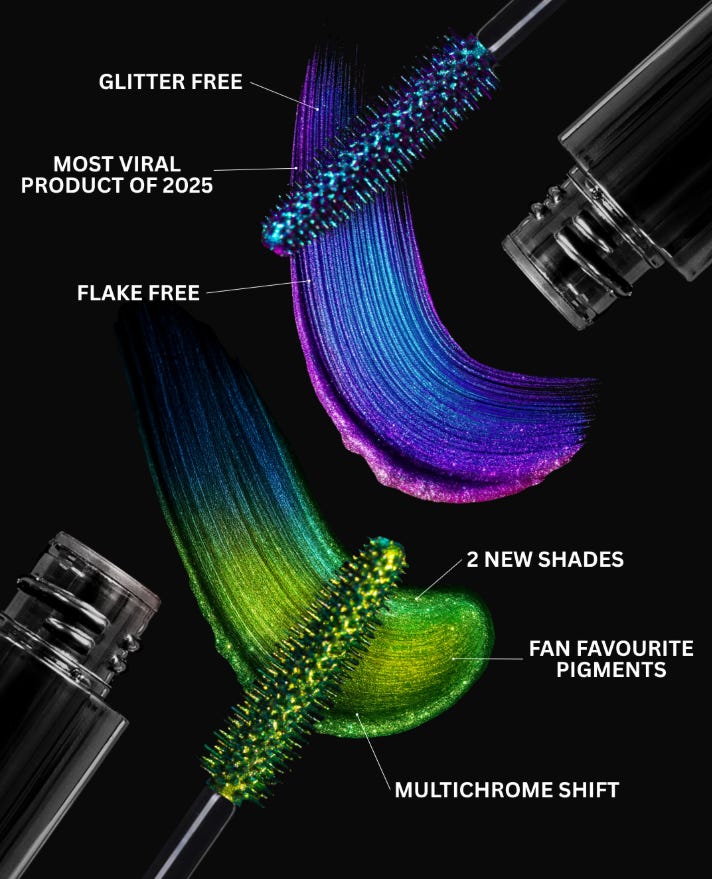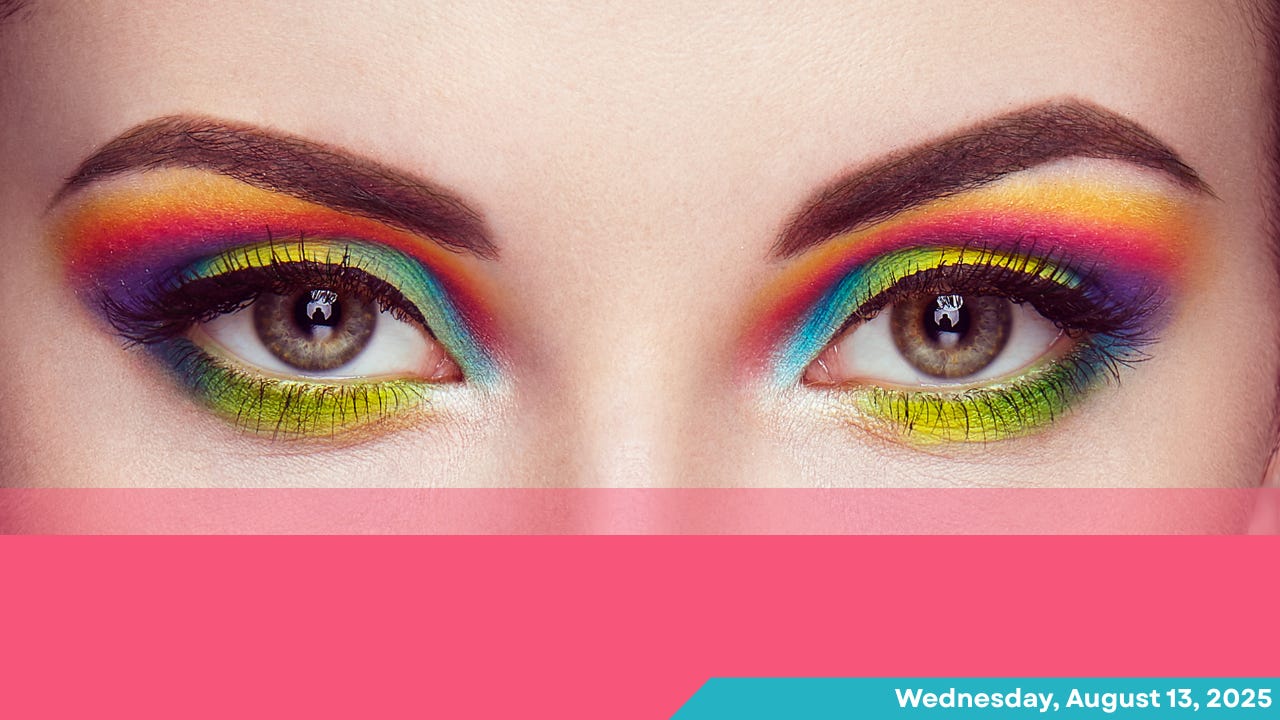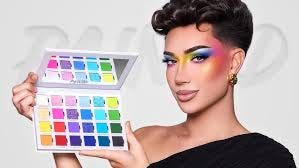Short answer: The mainstream can feel snoozy. But colorful, creative makeup is alive and well—and independent brands are in the best position to deliver it. If you’re tired of the same “clean girl” minimalism and taupe-on-taupe palettes, you’re not alone. Consumers are asking for artistry again. The data says the market is ready, and recent launches from indie players show how to answer the call.
Grab a coffee or your water. Let’s talk about where the color went—and how it’s coming back.
Why big brands look “safe” right now
The macro picture explains the wall of neutrals. Prestige beauty cooled in early 2025, while mass market grew slightly. When growth flattens, large companies protect volume with dependable shades and formats. That often means neutral eye palettes and a heavy shift toward lips. (Circana)
In 2024, prestige makeup dollars rose 5 percent, but lip was the star—up 19 percent year over year—so brands followed the demand. Eyes didn’t lead growth, which makes riskier eye launches harder to greenlight at scale. (Circana)
Zooming out, consultants expect global beauty to continue growing, albeit at a steadier pace—approximately 5 percent per year through 2030. That kind of “normal” growth encourages safer bets from the biggest players. (McKinsey & Company)
None of this means colorful makeup is dead. It means color needs a different kind of brand to champion it.
The opportunity: indie brands + artistry-first launches
Independent brands don’t need to please everyone in Ulta or Sephora to survive. They can target the fans who actually want saturated mattes, foil toppers, and true multichromes. That agility is evident in the numbers and the products.
Indie momentum is real. NIQ reports that indie beauty brands outpaced total beauty growth (15.7% vs. 9.9% year-over-year in 2023). That gap reflects the consumer's appetite for what indie brands are selling: novelty, texture, and a compelling color story. (NIQ)
Distribution favors the small and scrappy. In the first half of 2024, 41% of beauty and personal care sales took place online. E-commerce and social shopping lower the barrier to discovery, which helps niche color stories find their target audience. (NIQ)
Social is primed for color. In the UK, TikTok Shop has become a leading beauty retailer, with approximately one beauty product sold every second; social commerce is forecast to double by 2028. Bold textures and color-shifting finishes perform especially well in scrollable video. (The Times)
Search and trend trackers point to effects. Vogue Business’s tracker notes rising interest in multichrome eyeshadow, which aligns with what we see across indie launches. (Vogue Business)
Put simply, there’s room for bolder color stories, and the channels that drive growth today reward them.
Color is back—three proof points
Here are recent indie launches that show artistry is not only viable, it’s vibrant.
1) Painted by James Charles — Artistry Canvas Face & Eye Palette
James Charles has been vocal about wanting artistry back in makeup. His Artistry Canvas palette from Painted is a clear swing at that: 24 rainbow shades across mattes and shimmers, plus anchoring a white and black to mix, create graphic lines, and customize. It’s positioned as “bringing creativity back to makeup,” which tells you the intent. If you're looking for a single, bright toolkit, this is a good fit.
2) Blend Bunny x Ellis Atlantis — Ellis V2 Collection
Blend Bunny is known for smart gradient mattes and high-impact sparkle. The new Ellis Atlantis drop splits the difference between everyday and extra:
Imperial (Cool) 15-pan matte and Origin (Warm) 15-pan matte offer structured, workhorse mattes—yes, they skew pink, brown, and gray.
The Garden of Stars 18-pan shimmer eye & face palette is the showstopper—an all-shimmer constellation built for statement lids and transformative toppers. It’s the “artistry” half of the set.
This format—separate matte scaffolding with a dedicated shimmer engine—caters to both daily wear and creative play.


3) Question Beauty
Question Beauty has just launched two new shades of their mascara toppers and the 2nd Chapter of its limited edition series. Designed for eye artists, the mascara toppers come in 6 shades, including four that offer a multichromatic shift. The palette is an extension of the brand’s limited-edition Chapter series. Chapter 1, Legend of Land and Sea, and Chapter 2, Fable of Spice and Bloom, offer a mix of stunning, colorful mattes and multichrome shimmers.
“Clean girl” isn’t the only aesthetic anymore
Minimal skin and nude eyes had a long run, but the pendulum is swinging. Mainstream outlets are already calling out bolder eyes and creative detail work for 2025—graphic liner, vibrant shadows, and metallic accents. That’s not anti-natural; it’s pro-choice. It widens the lane for expressive looks again. (Real Simple, Allure)
Even seasonal trend coverage shows a pivot back to smokier, deeper tones and full-glam moments. That’s good news for any brand pushing color stories beyond beige. (Who What Wear, Glamour)
The business case for colorful launches (yes, there’s math)
If you’re an indie founder or just love to track the business side, here’s why leaning into color can pay off:
Category headroom. One analyst house estimates the global eyeshadow market at approximately $4.0 billion in 2025, with mid-single-digit growth projected throughout the decade. Eyes still matter, and upgrades in texture and payoff can win share. (Coherent Market Insights)
Differentiation premium. When prestige growth slows and big players default to neutrals, color becomes a point of clear difference. That can support price, build community, and justify focused SKU counts. (Circana)
Digital discovery loves effects. Multichromes, foils, and topper textures display dramatic before-and-after effects in short videos. That’s the exact content that fuels social commerce and creator collabs. (Vogue Business, The Times)
What beauty lovers are asking for
From my side of the screen, I hear the same things you do: “I miss the artistry.” “I want more than another latte palette.” The answer isn’t to cancel neutrals—it’s to add options that feel creative again.
Here’s what readers tell me they want, and what brands can deliver:
Smarter color stories. Think curated rows that actually build a look. Include anchoring shades (cream, taupe, black) plus purposeful brights.
Texture variety. One palette with mattes, satins, metallics, duochromes, and at least one true multichrome. That’s where the fun lives.
Instructions built in. Visual maps on the back of the palette or shade-by-shade “how to wear” on the product page.
Value clarity. Fewer duplicate shades and clearer pan sizing so the price makes sense.
Creator-led collabs. Partner with artists who demo looks and teach technique, like the Nueva Vida launch did. (YouTube)
For shoppers: how to bring artistry back to your routine
If you’re craving color but don’t want a drawer of palettes, try a small “effects wardrobe.” Keep your daily neutrals, then layer impact.
Start with one rainbow anchor. A compact rainbow or mixed-brights palette gives you every primary and a deepening shade for liner. Painted’s Artistry Canvas is built for that.
Add a shimmer engine. An all-shimmer palette like Garden of Stars lets you transform any matte look with one swipe.
Pick a multichrome single. One high-shift shade can turn a five-minute eye into something special. Trend trackers indicate that multichrome interest is on the rise for a reason. (Vogue Business)
My take
Makeup isn’t boring—scale is. The most prominent brands are managing risk in a normalized market, so they’ll keep investing in everyday neutrals and lip wins. That’s their job. Indie brands, on the other hand, can build for the people who want color. The economics of e-commerce and social shopping give them reach, and the trend cycle is ready for bolder eyes again.
If I ran an indie color line today, I’d launch tight, artistry-first capsules: a curated matte base (cool or warm), a companion shimmer/multichrome palette, and a few one-and-done sticks in unexpected tones. I’d show five real, wearable looks per launch and partner with artists who teach, not just post swatches. That’s how you bring artistry back without overwhelming the shopper.
Are you over the “clean girl” routine, or do you still love a soft neutral eye most days? Which indie palettes or multichromes have impressed you this year? Drop your picks in the comments.




